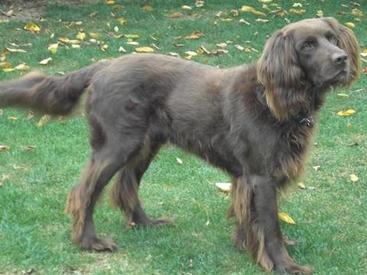
This article also relates to: German Wirehaired Pointer
Following WWII, the German Short-Haired Pointer was first introduced to the scene from Continental Europe and has since reaped great success in the field and show ring. Considered one of the world's most popular breeds, the Short-Haired Pointer is the result of crossing between the Spanish Pointer and Bloodhound. A close relation to this variety, the German Wire-Haired Pointer was developed in the 19th century for the purpose of retrieving fallen game from the water. A bristly-coated breed, the Wire-Haired Pointer has established itself in its own right, both as a friendly family companion and as resilient gun dog, suited to foul weather whilst hunting and tracking.
Both varieties of Pointer are well evolved for the purposes of hunting, with the Short-Haired proving a versatile breed possessing a proportionate body, long muzzle with wide nostrils, high-set ears and webbed feet. Deep-chested with enhanced lung capacity for stamina, the Short-Haired Pointer is suited to endurance with a tight coat that does not run the risk of becoming entangled whilst out in a rural and untamed setting. Similarly, the Wire-Haired Pointer boasts comparative features to its cousin, yet has a dense double-coat, helping to protect the dog from extreme temperatures. Both are common in colour variations of liver, white and black with dappling or spotting of the coat. The modern Pointer is utilised in showing, obedience, tracking, retrieving, as a gun and watch dog, and in field trials.
An active and intelligent breed, the Pointer was primarily developed to provide a loyal and companionable house dog, a fearless hunter and a vigilant and responsive watch dog. These traits, bred into the Pointer from early on, remain present, rendering it one of the most versatile and desirable dogs of today. The average Pointer weighs 18-25 kg depending on its gender, with a life expectancy of 12-14 years when cared for accordingly.
Typically healthy and long-lived, the German Pointer is susceptible to certain health afflictions, of both serious and lesser degrees. Prone to hip dysplasia, a common problem across breeds, as well as eye degeneration and diseases, and arthritis. More threatening breed-specific ailments include skin cancers and tumours.
Do you own a German Longhaired Pointer? Let others know what they're like!
Related products
Advantage 80 Spot On Flea Control Large Cats and Rabbits
from £12.95
Advantage 40 Spot On Flea Control Cats, Small Dogs and Rabbits
from £12.95
Advantage 250 Spot On Flea Control Large Dog
from £12.95
Advantage 100 Spot On Flea Control Medium Dog
from £12.95
Drontal Tasty Bone Wormer Tablets for Small & Medium Dogs (2 to 20kg)
from £2.15
TermaWorm™ Tablets for Cats & Dogs
from £1.79
Drontal Tasty Bone XL Wormer Tablets for Large Dogs (Over 20kg)
from £6.39
Advantage 400 Spot On Flea Control Extra Large Dog
from £12.95